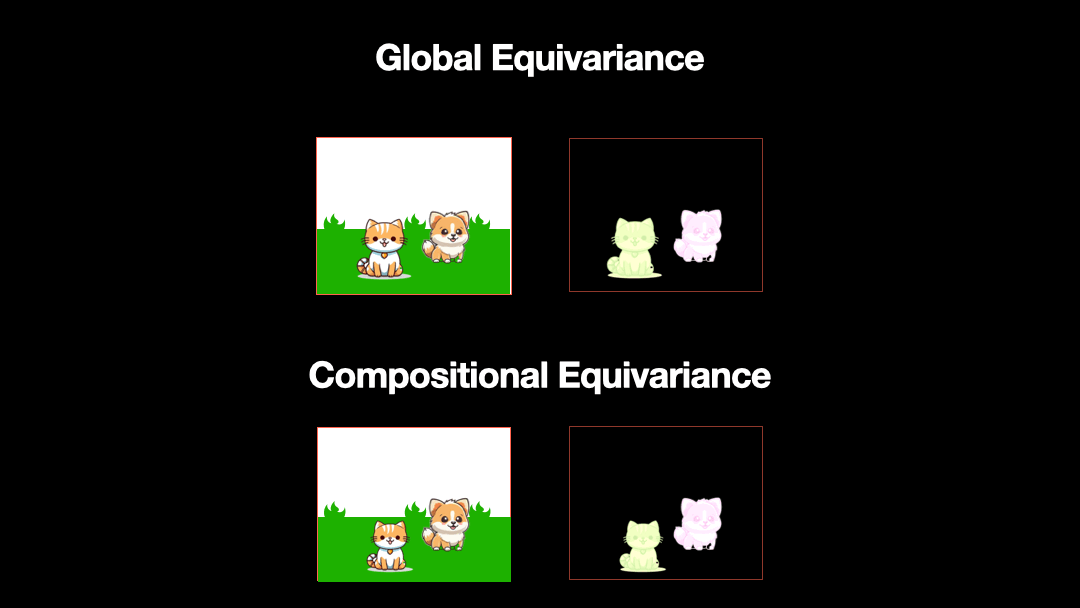While we show that the numerical optimization tends to look like Cake-Wavelets, we would like to theoretically derive the optimal wavelet. In this section, we propose a derivation of the optimal coherent state for lifting to a discretized SE(2).
Uncertainty Principle
The optimality of Gabor Wavelets with respect to position-momentum is well known in signal processing and computational neuroscience.
These wavelets can be derived from the Heisenberg Uncertainty Principle, given by the Cauchy-Schwartz inequality,
$$
<\hat{X}^2>_\psi <\hat{P}^2>_\psi \geq \frac{1}{4} \hbar^2
$$
where \(\hat{X}\) and \(\hat{P}\) are the position and momentum operators.
This equation means that the variance of the position of a wavefunction \(\psi\), given by \(<\hat{X}^2>_\psi\), and the variance of the momentum, given by \(<\hat{P}^2>_\psi\), cannot be arbitrarily small at the same time.
Strict equality for a function \(\psi^*\) holds when,
$$
\hat{X}[\psi^*] = i\lambda \hat{P}[\psi^*]
$$
For the position operator, \(X[\psi] = x\psi\), and momentum operator, \(P[\psi] = i\hbar \frac{\partial}{\partial x}\), equality holds for the Gaussian, or more generally \textit{Gabor}, wavefunction.
More generally, the Uncertainty Principle can be generalized to
$$
<\hat{X}^2>_\psi <\hat{Y}^2>_\psi \geq <\frac{1}{2} [\hat{X}, \hat{Y}]^2>_\psi
$$
where \([\hat{X}, \hat{Y}]\) is the commutator, or Lie bracket, of the operators \(\hat{X}\) and \(\hat{Y}\).
If we consider the generators for position and orientation, \(\hat{X}\) and \(\hat{\Theta}\), we can derive the optimal wavelet for lifting to SE(2).
The generators are given by the operators,
$$
\hat{X} = x\frac{\partial}{\partial x} + y\frac{\partial}{\partial y}
$$
$$
\hat{\Theta} = \frac{\partial}{\partial \theta}
$$
where \(x\) and \(y\) are the position coordinates, and \(\theta\) is the orientation coordinate.
Thus, \(\psi^*\) is optimal when,
$$
\frac{\partial}{\partial \theta}\psi^* = \frac{\rho}{\lambda} \sin \theta \psi,
$$
making \(\psi^*\)
$$
\psi^* = \frac{1}{C(\rho)} e^{\frac{\lambda}{\rho} \cos \theta},
$$
which is the Von Mises distribution.
If we consider the continuous form of the fast reconstruction constraint,
$$
\int_{0}^{2\pi} \frac{1}{C(\rho)} e^{\frac{\lambda}{\rho} \cos \theta} d\theta = 1
$$
we can solve for \(C(\rho)\) as the normalization constant of the Von Mises distribution, which is given by
$$
C(\rho) = 2\pi I_0(\frac{\lambda}{\rho}).
$$
This gives the optimal wavelet if we consider the continuous form of the fast reconstruction constraint.
However, for the discrete form, we must consider the discretization of the SE(2) group.
Slicing
To account for the discretization of the SE(2) group, we must propose a rearrangement of the fast reconstruction property, by partitioning the integral.
For a continuous Lie group \(G\), we can restate the fast reconstruction property as
$$
\int_{G} \psi_g dg = \mathbb{1}
$$
then we can partition the integral as
$$
\int_{G} \psi^*(g) dg = \sum_{h\in H} \int_{G/H} \psi_{hg} dg = \mathbb{1}
$$
for some discrete subgroup \(H\) of \(G\).
We can then consider the optimal wavelet, \(\phi^*\), for the discrete subgroup \(H\), in terms of the optimal wavelet for the full group, \(\psi^*\), by integrating over the quotient space \(G/H\).
$$
\phi^*_h = \int_{G/H} \psi^*(hg) dg
$$
Thus, we can derive the optimal wavelet for the discrete SE(2) group by integrating the Von Mises distribution over the quotient space of the SE(2) group,
$$
\phi^*_0 = \int_0^{\pi/N} \frac{1}{C(\rho)} e^{\frac{\lambda}{\rho} \cos \theta} d\theta
$$
Smoothness Penalty
When considering the smoothness penalty, the continuous coherent state becomes that of SIM(2), rather than SE(2).
This was derived in JP Antoinne's paper.
As SE(2) is a subgroup of SIM(2), one can obtain the von Mises distribution by integrating over the quotient space of SIM(2)/SE(2) using the above slicing trick.
(I think this is the case, but I am not sure. I need to check this.)




